History
The Steiner Minimum Tree problem has the last forty years gotten widespread attention, but its history goes back four centuries. Although many of the scientists in the early years did not publish their work in books or articles, the notes and letters they have left, gives us today a possibility to trace the evolution of the Steiner Minimum Tree problem.
 Pierre de Fermat (1601-1665)
Pierre de Fermat (1601-1665)
In the early 1600, Fermat proposed the following problem: given 3 points in the plane, find a fourth point T such that the length from this point to the 3 given points is minimal.
The original treatment of the problem considered only triangles with acute angles, for which T must be an interior point. Therefore, a discussion of the relative position of T with respect to the triangle did not emerge.
Before 1640, Torricelli solved this problem and the point has since been known as the Torricelli-point. Torricelli's method was to construct equilateral triangles on each side of the triangle made up by the original points. Circles circumscribing the equilateral triangles intersect in the point that is sought (Figure 1). This point is called the Torricelli point.
 Evangelista Torricelli (1608-1647)
Evangelista Torricelli (1608-1647)
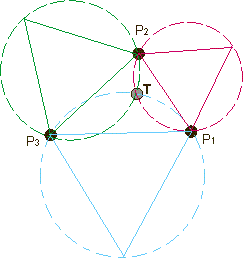
Figure 1: Torricelli method.
 Bonaventura Francesco Cavalieri (1598-1647)
Bonaventura Francesco Cavalieri (1598-1647)
Cavalieri in his "Exercitationes geometricae" of 1647, showed that the sides of the
given triangle subtend angles of 120 degrees from the Torricelli point.
Thomas Simpson proved in his "Doctrine and Application of Fluxions" (London, 1750), that the three lines joining the outside vertices of the equilateral triangles defined above, to the opposite vertices of the given triangle intersect in the Torricelli point. These three lines are called Simpson lines (Figure 2). He is also credited as being the first to discuss the weighted variant of the problem, and having generalized the problem to n points.
 Thomas Simpson (1710-1761)
Thomas Simpson (1710-1761)
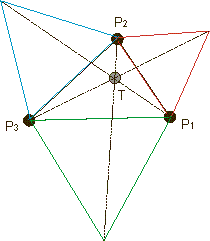
Figure 2: Simpsonís method.
A method proposed by the mathematicians of the mid seventeenth century for the three point problem is illustrated in Figure 3. This method stated that in order to calculate the Steiner Point given points A, B and C, you first construct an equilateral triangle (ABX) using the longest edge between two of the points (AC) such that the third (B) lies outside the triangle. A circle is circumscribed around the triangle, and a line is constructed from the third point (B) to the far vertex of the triangle (X). The location of the Torricelli point (T) is the intersection of this line (BX) with the circle.
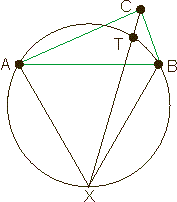
Figure 3: Method used in mid 1700.
In 1834, Heinen showed that the Toricelli point is only the solution to Fermat's problem if the triangle of the three given points does not contain an angle larger than 120 degrees.
The Steiner minimum tree problem is an indirect generalization. Recent research on mathematical history showed that Gauss first studied this generalization (i.e., the Steiner minimum tree).
 Johann Carl Friedrich Gauss (1777-1855)
Johann Carl Friedrich Gauss (1777-1855)
On March 19th., 1836 the astronomer Schuhmacher wrote a letter to his friend the mathematician Gauss in
which he was surprised about a specific case of the Fermat problem. He considered four points v1, v2, v3, v4 in
the plane which forms a quadrilateral such that the segments v1v2 and v3v4 are parallel and the lines of the
segments v1v3 and v2v4 meet in one point v outside. Now the Torricelli point T of these four points is the
intersection point of the diagonals v1v4 and v2v3 Schuhmacher did not understand the fact that, if the
segment v3v4 runs to the point v the point q runs in the same way to v, but this cannot be, since the Torricelli point of three points
is not necessarily one of the given points.
In an answer, March 21, Gauss answered that Schuhmacher did not consider the Fermat problem, he looked for a solution of:
||v1 - w|| + ||v2 - w|| + 2 * ||v3 - w|| = min!
More important was the next remark of Gauss He said that it is natural to consider the following, more generally problem :
"Ist bei einem 4Eck ... von dem kurzesten Verbindungssystem die Rede ..., bildet sich so eine recht interessante mathematische Aufgabe, die mir nicht fremd ist,
vielmehr habe ich bei Gelegenheit eine Eisenbahnverbindung zwischen Harburg, Bremen, Hannover, Braunschweig...in Erwagung genommen ...."
That means, in English, how can a railway network of minimal length which connects the four German cities Bremen, Harburg (today a part of the city of
Hamburg), Hannover, and Braunschweig be created?
In such a generalized Fermat problem we are given a certain number of points in a plane which are to be connected by a system of curves of smallest total
length. The concrete problem by Gauss was completely discussed by Bopp in 1879. Today it is easy to see that a solution
is given in a network in which
Bremen, Harburg and Hannover are interconnected by their Torricelli point and Hannover and Braunschweig are connected by a straight line (In our figure
this is marked with the bold line, the thin line is an MST). (1)
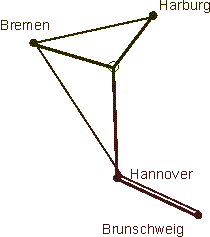
Figure 4: Gauss's question
 Jakob Steiner (1796-1863)
Jakob Steiner (1796-1863)
In the nineteenth century a professor of mathematic at the University of Berlin, named Jakob Steiner, studied the Fermat problem and generalized it to include an arbitrarily large set of points in the plane. This generalization created a star when P was connected to all the given points in the plane, and is a geometric approach to the dimensional center of mass problem.
In 1934 Jarnik and Kossler generalized the network minimization problem even further: Given n points in the plane find the shortest possible connected network containing these points. This generalized problem however did not become popular until the book "What is Mathematics" by Courant and Robbins appeared in 1941. Courant and Robbins linked
the name Steiner with this form of the problem proposed by Jarnik and Kossler and it became known as the Steiner Minimal Tree problem. The general solution to this problem allows multiple points to be added, each of which is called a Steiner Point creating a tree instead of a star.
In 1961 Melzak developed the first known algorithm for calculating an SMT. His algorithm was geometric in nature and was based upon some simple extensions to Figure 3.
Hannan showed in his article "On Steiner's problem with rectilinear distance" in 1966, that Manhattan SMT can be reduced to the Steiner tree problem in finite grid graph: there always exists an optimum solution where all line segments lie on the grid induced by the coordinates of the terminals.
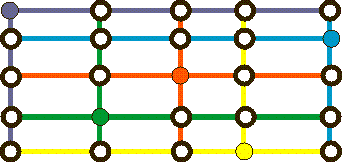
Figure 5: Hanan Grid.
The Manhattan SMT is today normally known as the rectilinear Steiner minimum tree, or just RSMT.
In 1968 Gilbert and Pollak, in theirs article "Steiner minimal trees", linked the length of the SMT to the length of a MST. It was already known that the length of an MST (minimum spanning tree) is an upper bound for the length of an SMT, but their conjecture stated that the length of an SMT in the Euclidean plane would never be any shorter than sqr(3)/2 times the length of an MST. This conjecture was first proved in 1990 by D.-Z. Du and F.K. Hwang in Proceedings of National Academy of Sciences U.S.A., 87.
In 1976 gave F.K. Hwang a precise description of the topology of rectilinear FST (Full Steiner Tree, a Steiner tree where all terminals is leafs) in On Steiner minimal trees with rectilinear distance. He proved that there always exists an SMT for which every FST is one of two generic forms shown in Fig.5.
He also proved that the Steiner ratio for the rectilinear Steiner problem is 2/3.
 |
|
 |
| Figure 6: Hwang topology - type I |
|
Figure 7: Hwang topology - type II |
M.R. Garey, R.L. Graham, and D.S. Johnson proved in "The complexity of computing Steiner minimum trees" in 1977, that the Rectilinear Steiner problem is NP-complete.
Industry
The RSMT problem has numerous applications in the area of VLSI design automation as
well as printed circuit board layout. For example, an RSMT for a set of electron devices can be used as a lower bound estimate on the wire length of a route connecting all of the devices together. An RSMT of the points represents only a lower bound since a real interconnect satisfies additional constraints requiring it to avoid other obstacles that are also present on the chip. Recent work by Ganley treated such obstacle avoiding RSMTs directly. In addition to global wire length estimation, RSMTs have also been used to evaluate the merit of functional block placements in floorplanners such as the MONDRIAN system.
Wagner reduces certain cases of parallel expression evaluation to the RSMT problem.
The ESMT problem has applications in the design of electrical power distribution
Networks, oil and natural gas pipelines and other network design problems.
1 From Dietmar CIESLIK:
SHORTEST CONNECTIVITY - An Introduction with Applications in Phylogeny
Copyright: Pictures is primarily taken from The MacTutor History of Mathematics archive at http://www-groups.dcs.st-and.ac.uk. Their copyright statement is:
We do not own the copyright to the images used on this website. We believe that most of the images are in the public domain and that provided you use them on a website you are unlikely to encounter any difficulty. However, if you wish to use them in any other way -- in "paper" publishing or on a CD for example -- we cannot guarantee that there may not be outstanding copyright problems.
We have not kept a record of where we found any of the images we have used. If you believe that you own the rights to any of the images we use, please contact us and we will either withdraw that picture or add an acknowledgement. JOC/EFR August 2001
 Pierre de Fermat (1601-1665)
Pierre de Fermat (1601-1665) Evangelista Torricelli (1608-1647)
Evangelista Torricelli (1608-1647)

 Bonaventura Francesco
Bonaventura Francesco  Thomas Simpson (1710-1761)
Thomas Simpson (1710-1761)


 Johann Carl Friedrich
Johann Carl Friedrich 
 Jakob Steiner (1796-1863)
Jakob Steiner (1796-1863)

